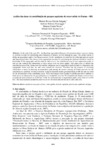Use este identificador para citar ou linkar para este item:
http://www.alice.cnptia.embrapa.br/alice/handle/doc/963371Registro completo de metadados
| Campo DC | Valor | Idioma |
|---|---|---|
| dc.contributor.author | SALGADO, M. P. G. | pt_BR |
| dc.contributor.author | FORMAGGIO, A. R. | pt_BR |
| dc.contributor.author | NEVES, M. C. | pt_BR |
| dc.contributor.author | LUIZ, A. J. B. | pt_BR |
| dc.date.accessioned | 2013-08-05T11:11:11Z | pt_BR |
| dc.date.available | 2013-08-05T11:11:11Z | pt_BR |
| dc.date.created | 2013-08-05 | pt_BR |
| dc.date.issued | 2013 | pt_BR |
| dc.identifier.citation | In: SIMPÓSIO BRASILEIRO DE SENSORIAMENTO REMOTO, 16., 2013, Foz do Iguaçu. Anais... Foz do Iguaçu: INPE, 2013. p. 6830-6836. | pt_BR |
| dc.identifier.uri | http://www.alice.cnptia.embrapa.br/alice/handle/doc/963371 | pt_BR |
| dc.description | Abstract: At the end of the year 2011 the Brazilian Agricultural Research Corporation started a project aiming to develop a model for monitoring and evaluation of impacts on fish farming in cages. The project needs to define an aquaculture park of the Furnas reservoir for the installation of a platform for collecting meteorological and limnological data. The choose of the appropriate location for positioning the platform should be based on knowledge of the topography and the land use and cover of the contribution area of each aquaculture park, so that we can establish the relationship of these factors with the water quality. This paper aims to delimit the contribution area of the Furnas reservoir and the catchment area of aquaculture parks in order to characterize the topographic factor and land use and cover around the reservoir. Therefore has the purpose of collecting information to assist in choosing an aquaculture park among the sixteen existing in Furnas reservoir for the installation of a platform for data collection. A digital elevation model generated based on SRTM data was used for the delimitation of the contributing areas. Were used images from Landsat-5 and ResourceSat-1 addition to field surveys to characterize the use and land cover around the reservoir. We found that the Furnas reservoir have a catchment area estimated at 52.264 km2 while the catchment area of aquaculture parks varies from 2.5 to 630 km2. The main land uses around the reservoir are for livestock and cultivation of coffee and corn. | pt_BR |
| dc.language.iso | por | pt_BR |
| dc.rights | openAccess | pt_BR |
| dc.subject | Pisciculture | pt_BR |
| dc.subject | Área de captação | pt_BR |
| dc.subject | Captação de água | pt_BR |
| dc.title | Análise das áreas de contribuição de parques aquícolas do reservatório de Furnas - MG. | pt_BR |
| dc.type | Artigo em anais e proceedings | pt_BR |
| dc.date.updated | 2013-08-05T11:11:11Z | pt_BR |
| dc.subject.thesagro | Piscicultura | pt_BR |
| dc.subject.thesagro | Qualidade da água | pt_BR |
| dc.subject.thesagro | Sensoriamento remoto | pt_BR |
| dc.subject.nalthesaurus | Fish culture | pt_BR |
| dc.subject.nalthesaurus | Water quality | pt_BR |
| dc.subject.nalthesaurus | Remote sensing | pt_BR |
| riaa.ainfo.id | 963371 | pt_BR |
| riaa.ainfo.lastupdate | 2013-08-05 | pt_BR |
| dc.contributor.institution | MOISÉS PEREIRA GALVÃO SALGADO, INPE; ANTÕNIO ROBERTO FORMAGGIO, INPE; MARCOS CORREA NEVES, CNPMA; ALFREDO JOSE BARRETO LUIZ, CNPMA. | pt_BR |
| Aparece nas coleções: | Artigo em anais de congresso (CNPMA)  | |
Arquivos associados a este item:
| Arquivo | Descrição | Tamanho | Formato | |
|---|---|---|---|---|
| 2013AA09.pdf | 675,95 kB | Adobe PDF |  Visualizar/Abrir |









